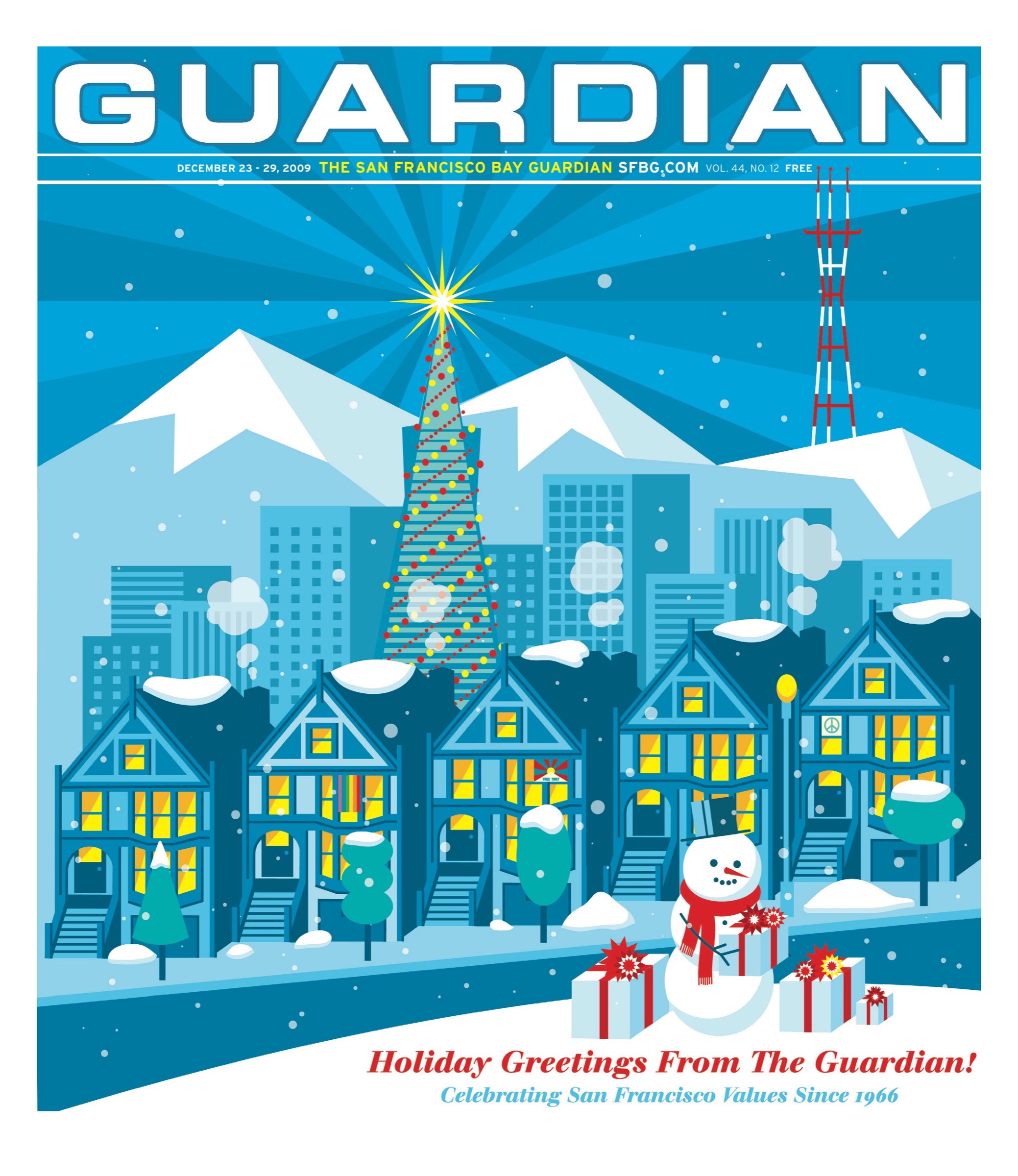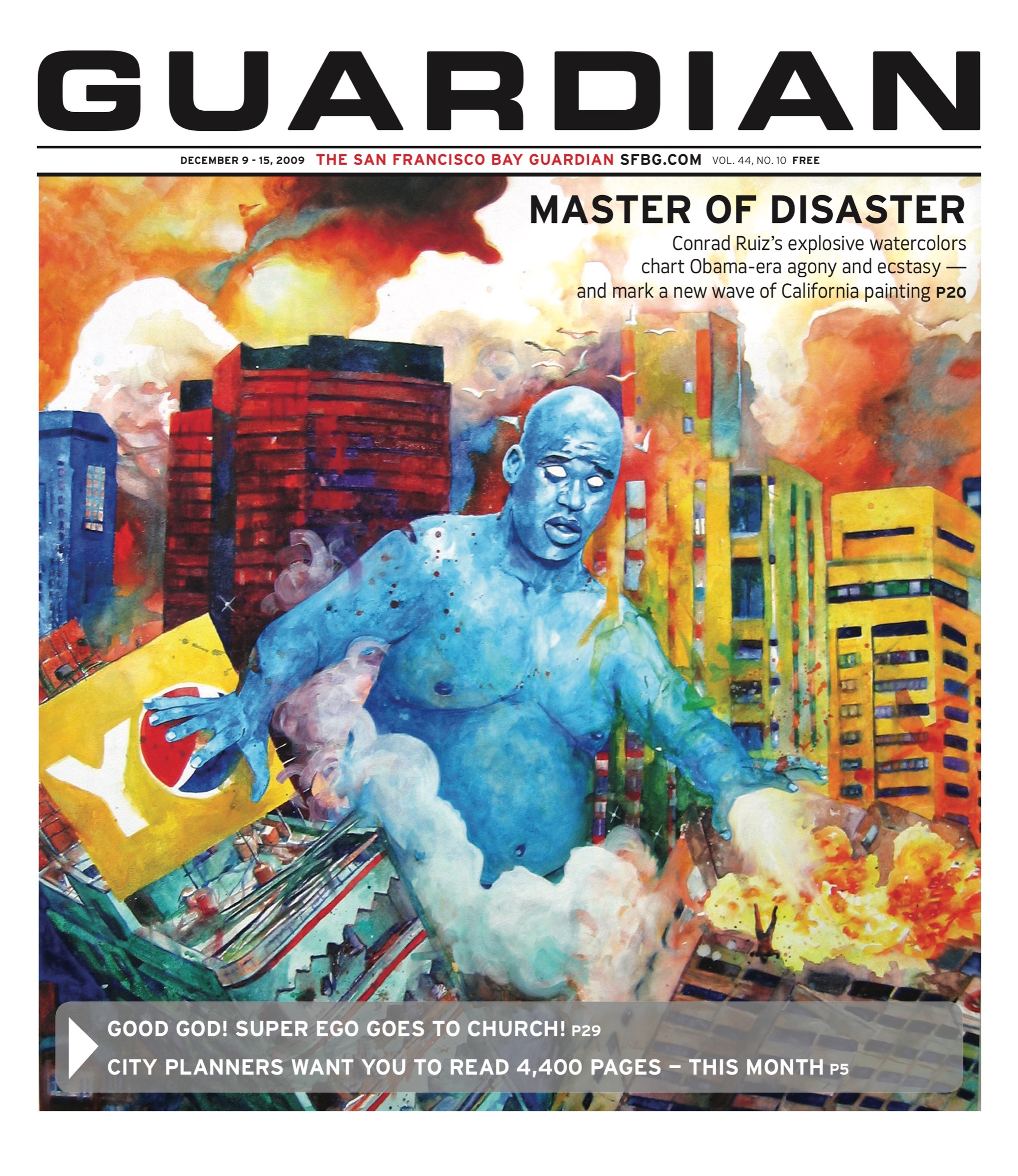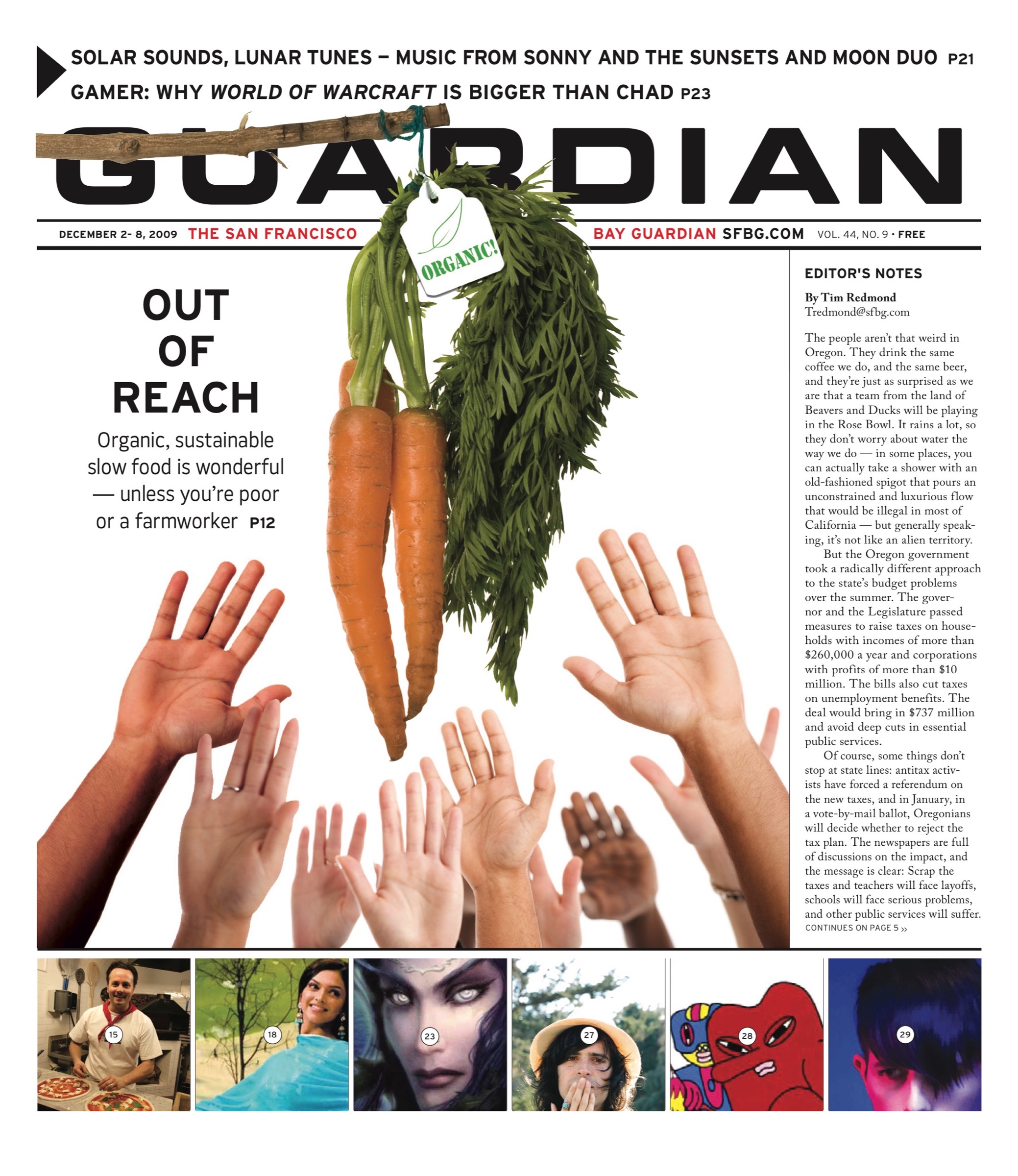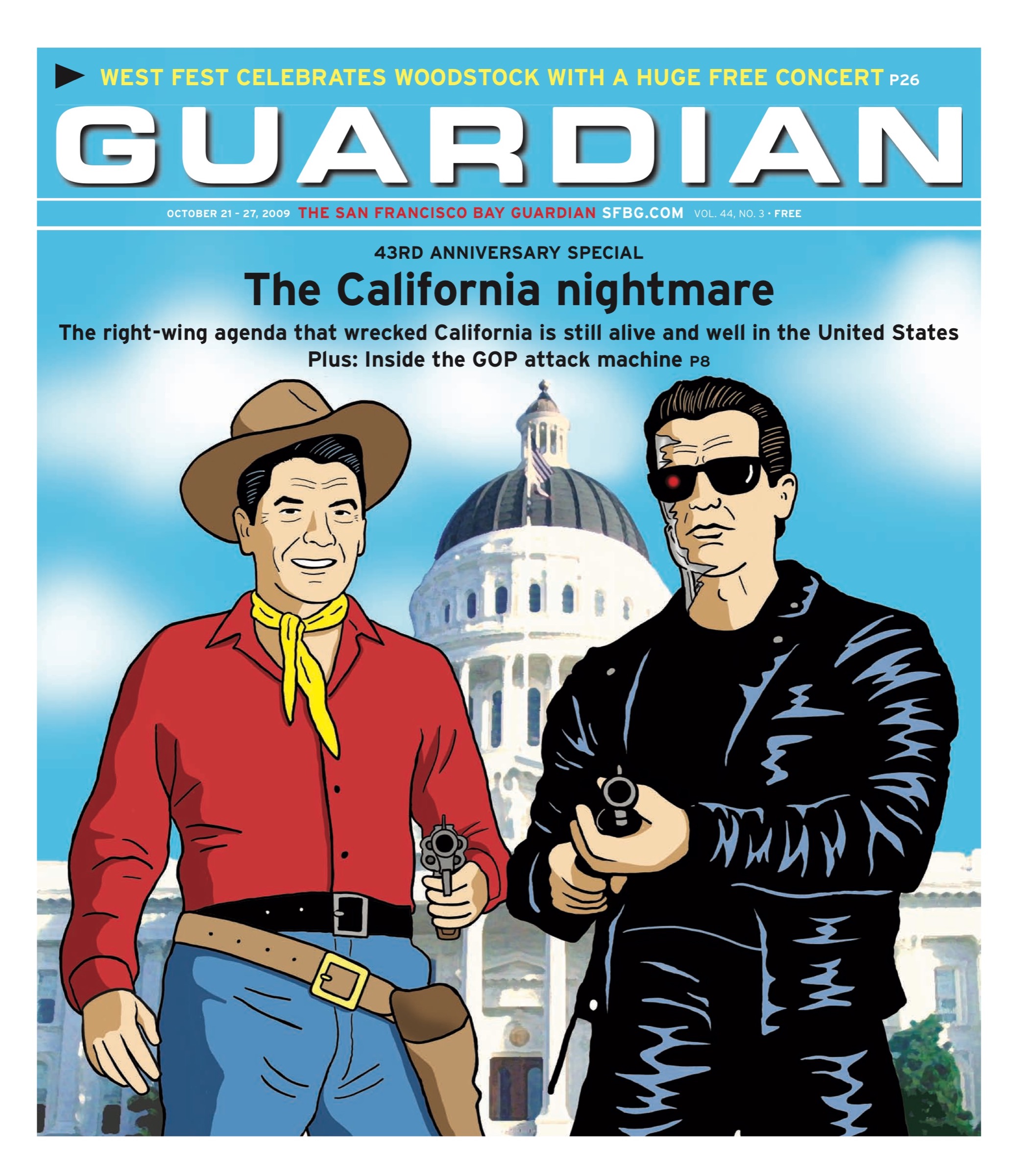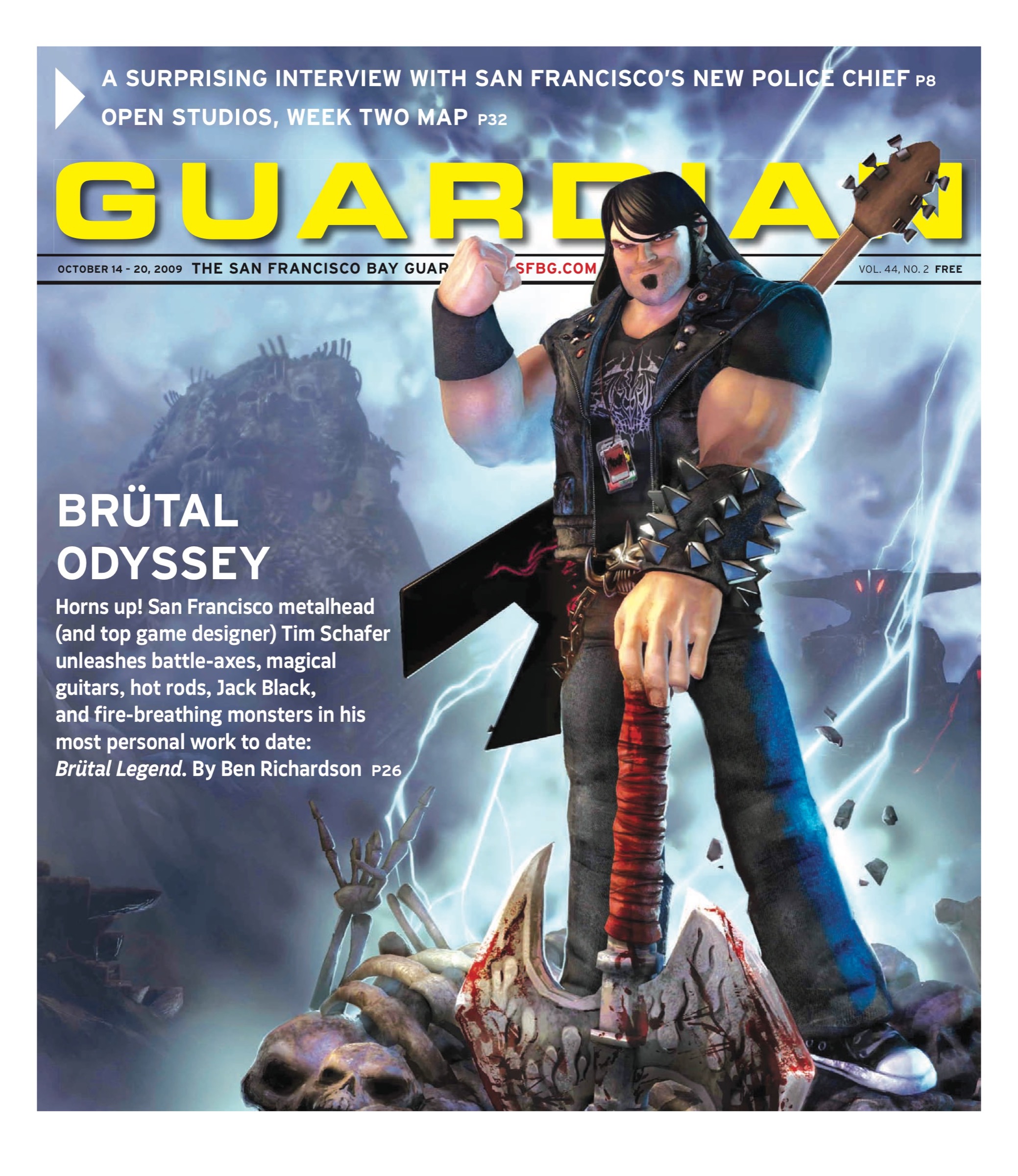arts@sfbg.com
MUSIC Last December, Anticon celebrated its 10th anniversary with a concert at the Knitting Factory in New York. It was an emotional reunion. Many fans flew from around the world to see a hip-hop collective that hadn’t performed together since a 2002 concert at Slim’s in San Francisco. Peter Agoston, the event’s promoter, says it took a year to pull it together.
This was a far cry from 1999, when most of the original Anticon seven (along with more than a few couch-surfers) lived communally in an East Oakland warehouse. Tim "Sole" Holland, Adam "Dose One" Drucker, Yoni "WHY?" Wolf, Brendon "Alias" Whitney, Jeffrey "Jel" Logan, David "Odd Nosdam" Madson and James Brandon "the Pedestrian" Best sought to revolutionize hip-hop, injecting the art form with absurdist humor and beatnik poetry. Every month, they held court at Rico’s Loft in San Francisco, performing college radio hits like "It’s Them" and "Rainmen" as throngs of Bay Area backpackers shouted along. Doseone, Anticon’s madcap poet, says, "We were crew, posse, label, brotherhood, and boys-club."
A decade later, Anticon has become a brand and a myth. Baillie Parker, who faithfully attended those Rico’s Loft showcases, became an eighth member, label manager, and co-owner in 2001. Slowly (and sometimes painfully), he steered the label toward solvency, streamlining the collective’s unpredictable adventures into a small business. Then he ceded day-to-day responsibilities to his former intern Shaun Koplow, a student at UC Berkeley. After Koplow graduated, he moved back to his native Los Angeles, and now runs the label there.
Today, Anticon Records is surprisingly durable and stylistically varied. Recent albums include melancholy rock (Anathallo’s Canopy Glow, 2008), wintry indietronica (Son Lux’s At War With Walls and Mazes, 2008) and punchy, synthesized instrumental beats (Tobacco’s Fucked Up Friends, 2008).
Meanwhile, the collective that founded the label has splintered and scattered across the country. Some remained in the Bay Area (Dose One, Jel, Odd Nosdam, and Parker) while others moved elsewhere (Sole in Denver, Colorado; Alias in Portland, Maine; and the Pedestrian in Los Angeles; Yoni Wolf is currently "homeless" while he embarks on a months-long tour). They still own the label and make major decisions together. However, each pursues his individual career. Some collaborate, others do not.
What does it all mean? It doesn’t take a Rashomon-like investigation to figure it out. "We all send each other friendly [e-mail] messages every few months, but we’re not like this cult. And I think that’s good," says Sole. "When we tried to be a cult, we realized that none of us made very good cult members."
ORIGINS OF AN ICON
Anticon’s symbol is an ant, designed by Aaron Horkey of Burlesque Design. Ant-icon. The name comes from the Pedestrian, a Los Angeles native, and Sole, who grew up in Portland, Maine. The two met in 1992 on a Prodigy message board for cassette trading. Both were avid tape collectors, the lingua franca for music dispersion before the Napster era. They bonded over a love for the Los Angeles scene, where Freestyle Fellowship and the Shapeshifters pioneered speed-rapping and obtuse, free-associative rhymes; early Midwest battle-rap crews like Atmosphere and 1200 Hobos; and obscure Canadian groups like the Sebutones.
Anticon coalesced around a series of fortuitous happenings. Alias and Sole met when both lived in Portland; there was the 1997 Scribble Jam, famous in rap circles for its battle between Dose One and a pre-Slim Shady Eminem; Doseone’s frenzied networking skills brought him in touch with Jel, and then Sole; and Dose One made fast friends with WHY? and Odd Nosdam when he lived in Cincinnati in the late 1990s.
After Sole and the Pedestrian came up with the Anticon concept in 1998, Sole moved to Oakland to work for Listen.com. The rest of the crew eventually followed him there. "I was making $50,000 a year during the dot-com rush," he says. "I didn’t have any expenses, so I just put all the money into starting the label."
Anticon’s first release, 1999’s Music for the Advanced Hip Hop Listener EP was an invitation and a challenge, with Alias’ "Divine Disappointment," which imagines an argument between father and son, and "Holy Shit," a posse track marked by precociously off-kilter rap flows. A compilation, Music for the Advancement of Hip-Hop, followed later that year. "For me, it was about representing these underground aesthetic movements," says the Pedestrian.
But the only song anyone remembers from those records was Sole’s missive "Dear Elpee." On the surface, it was a battle record directed at El Producto, the incredibly talented rapper/producer whose group Company Flow recorded the 1997 opus Funcrusher Plus. El-P memorably coined the term "independent as fuck" to distance himself from mainstream rap, then lost in the throes of Puff Daddy’s hyper-commercial "jiggy" era. But Sole saw hypocrisy in East Coast tastemakers such as Rawkus Records, which distributed Company Flow’s records. He felt they excluded anyone who didn’t live in New York City, and was disgusted at how they extolled "independent" virtues while launching sophisticated marketing campaigns to promote themselves.
"Dear Elpee" wasn’t just a dis against a popular rapper, it was a distillation of Anticon’s scrappy, outsider stance. "Underground hip-hop is a mentality. It’s not supposed to be commercial. You’re supposed to spit an 80-bar verse and people are going to love it," says Sole. "I felt like [hip-hop] needed a little chin check."
On his subsequent two solo albums, 1999’s Bottle of Humans and 2001’s Selling Live Water, Sole honed his sarcastic and brutally honest persona. He criticized himself and attacked his unnamed enemies, exposing thoughts of paranoia and depression. With songs like the brilliantly melancholy title track, he sowed the seeds of what would later become known as "emo rap."
Meanwhile, Jel and Odd Nosdam (along with other producers such as Alias and DJ Mayonnaise) drew from a wide breadth of influences, from orchestral rock like Radiohead and Flying Saucer Attack to electronic acts like Boards of Canada. They made tracks using rudimentary equipment, including 4-track and 8-track recorders and SP-1200 sampling keyboards, resulting in songs that expounded a murky and intimate low-fi aesthetic.
Anticon’s recordings were imbued with a childlike playfulness. In 1998, Sole, Doseone, and Alias collaborated with Minneapolis rapper Slug [from Rhymesayers group Atmosphere] under the name Deep Puddle Dynamics. Alias explains the concept: "[The group name is] in reference to puddles … because of how they form, you sometimes can’t tell how deep they are until you stand in them or observe them really closely."
Deep Puddle Dynamics’ 1999 album, The Taste of Rain … Why Kneel (a title inspired by Jack Kerouac’s poem "Some Western Haiku"), mixed wide-eyed abstraction with introspective thoughts. On the yearning "June 26, 1998," they trade lines until their voices became a kind of Greek chorus. "What is the meaning of life?" they chant. "Fortune, health, knowledge, success / Woman, man, trust, progress / Culture, faith, healing, destiny / Endurance, family, science, society."
"It was so inspiring to be around those cats and see how they operate," says Alias of those recording sessions. His shy New England demeanor contrasted sharply with Doseone and Sole’s bravado. "It’s weird to go back and listen to it now. … It shows its age, and it shows its awkwardness."
However, Anticon’s precocious search for deeper truths through hip-hop, a genre often maligned for its lack of intellectual discourse, endeared them to listeners around the world. The collective helped spark a cottage industry of aspiring rappers, a sensibility built around tweaked flows and five-minute soliloquies, and nourished a brief, exhilarating moment of hip-hop experimentalism in the early 2000s.
Alias says, "I’ve been at shows and had kids come up and tell me how much my music has meant to them. They’ll tell me stories like when their father passed away, all they did was listen to ‘Watching Water’ [from The Other Side of the Looking Glass, 2002] for a week. Then they’ll show me that they have these Anticon-related tattoos or something. It’s crazy. It makes me feel embarrassed."
OFFBEAT STREET
If Sole is the blustery visionary who led Anticon into war, then Doseone is the eccentric who personifies its unfettered creativity. His catalog, issued via several record labels, ranges from the bleak tone poems of Circle, his 2000 album with producer Boom Bip; to Subtle, a band formed with Jel and keyboardist Dax Pierson. Over the course of three albums (including 2008’s Exiting Arm), Subtle molded rap, electronics, rock, jazz-fusion and whatever else they could find into a searing and dense whirlwind of word and sound.
"We were artists’ artists without a doubt. Still are," says Doseone. "It was DIY … and you could hear the flaws, the sensitivities, the trying-something-new, even when it was over the top or egregious."
Doseone’s strangely disembodied, half-sung raps epitomized Anticon’s greatness as an offbeat take on hip-hop culture. It should have made a bigger impact on the rap industry, and there are several reasons why it didn’t. First, Sole’s battle with the iconic El-P, whose music was just as experimental and groundbreaking as anything Anticon made, turned many people against him. And yes, Anticon was undoubtedly too weird for a generation raised on 2Pac and Jay-Z.
Most damaging were assumptions that Anticon was full of rich, ego-driven art-school snobs who made hip-hop for white people.
Those accusations struck Jel as funny. The Midwest native has been devoted to hip-hop for most of his life, and his placid, straightforward demeanor results from a staunchly lower-middle-class background. "All the shit that came out of nowhere about us not paying dues all comes from the racism that was involved," he says.
The Pedestrian admits that part of the problem was attitude. "When we were doing that whole pretentious ‘Music for the Advancement of Hip-Hop’ shit, for me it was about representing these underground aesthetic movements," he says. "I didn’t imagine we would look as white as we did. It really surprised the shit out of me. And in retrospect, we should have done things differently.
"In those early years, the crowd was pretty fucking white," he continued. "I know there was definitely a consciousness about it — we were thinking about it. But we were fucking kids. We didn’t know how to deal with these really difficult situations."
By the summer of 2002, when Anticon held a series of come-to-Jesus meetings to determine the label’s future, all of its members realized they weren’t a hive-mind group of crazy MCs à la Wu-Tang Clan (with Sole as the RZA), but eight very different people. Wolf, whose esoteric music masks a highly disciplined songwriting approach, felt those aspirations were "unrealistic." "There was almost a utopian idea about record-making, that it could almost be a socialist affair," he says.
As Anticon evolved from a movement into a traditional company, it meandered creatively and financially. Some released material that paled in comparison to past efforts (Sole’s Live from Rome, 2005). New signings, such as indie-pop multi-instrumentalist Dosh (self-titled, 2003) struggled to gain recognition for music that had nothing to do with hip-hop. Eventually, though, Anticon Records learned how to promote releases by its onetime collective as well as its growing indie-rock and electronic roster.
"The way it’s perceived by artists, particularly rock artists, I think they see it as a natural progression," says Sole of Anticon Records’ development. "All the outside-of-hip-hop-world friends we’ve made over the years see it as a natural evolution because what we’ve done has always been pretty melodic and rock and musical anyway."
Some of the onetime "cult" members who felt overshadowed during those early years forged individual identities. Alias, who always felt "awkward" when he rapped, moved back to Maine with his wife and focused on production instead. His efforts yielded 2007’s Brooklyn/Oaklyn, an evocative collaboration with Brooklyn singer Rona "Tarsier" Rapadas.
After a somewhat uneven solo debut (2003’s Oaklandazulasylum), Wolf formed a trio under his old WHY? moniker. Their next two albums (Elephant Eyelash, 2005; Alopecia, 2008) impressively blended Wolf’s prior talent for harmonies, loquacious wordplay, and poetic imagery with the band’s newly-minted melodic rock arrangements. By scoring rapturous national press, he epitomized Anticon Records’ new status as a fast-rising independent label.
WHY? just released its fourth album, Eskimo Snow, which consists of unused material from the Alopecia sessions. Wolf still does a fair amount of rapping, or rhyming in rhythm, even if the results can no longer be classified as strictly hip-hop. "I’ve incorporated it into my pantheon of musical styles," he says, adding that "the next record could be a disco record, for all I know."
BRAND OF OUTSIDERS
Anticon hasn’t abandoned hip-hop. Doseone and Jel just released their third album as the cryptically-named Themselves; their 2000 debut was notable for producing the indie-rap classic "It’s Them." With CrownsDown, Doseone returns to the arena he once flourished in. "There’s purity to the construction and presentation of this record that is derived from Guru and Premier," Doseone says, referring to the classic rap duo Gang Starr.
This year has also brought Chicago duo Serengeti & Polyphonic’s Terradactyl; and Bike for Three!, a collaboration between Buck 65 (formerly of Sebutones) and Belgian electronic musician Greetings from Tuskan. The difference between now and 10 years ago is that these albums aren’t the latest missives from Anticon the collective. They just enhance the label’s reputation for honest, lyrically-driven, complex music.
Amid all this activity, Anticon’s original theorists seem like the odd men out. Back in the day, the Pedestrian was the crew’s sardonic (and sometimes arrogant) prankster, sending out eloquent and confrontational press releases inspired by Dadaism and Situational Ethics. By 2002, however, the former high-school dropout went back to school, enrolling in Laney College. He transferred to UC Berkeley, earned a degree in literature, then enrolled at the University of Southern California, where he’s working on a PhD in ethnic studies.
"There was once an aesthetic collective. And now we’re a record label whose brand name has some lingering connection to that aesthetic," says the Pedestrian, who still treats hip-hop as a hobby and elaborate game theory. "But what we decide to put out and the music we all make is infused with those early years of collaboration. Those were important, foundational years for all of us."
Sole lives in Denver with his wife, and works as an IT technician for Denver Open Media, a public-access station. "It’s not my label anymore. I’m just one voice in it, and I try to contribute as meaningfully as I can to it," he says, adding that he wishes Anticon had a traditional rap profile. So for his new album, Plastique, he decided to work with Fake Four Inc., home to underground artists like Awol One and Mikah 9 (from Freestyle Fellowship).
With Plastique, he focuses on a wide-ranging critique of political injustice, capitalism, and Western hegemony, fed by radical works like Kurt Vonnegut’s Slaughterhouse Five and Guy Debord’s Society of the Spectacle. Sometimes, Sole fits the American lone wolf profile, railing about the world’s troubles.
"Do I wish it was still a crew? Yeah. I miss that. To me, that’s what it’s all about," he says. "But when you’re married, you don’t want to be hanging out all the time. You want to be home, making a stew and watching Heroes."
WHY?
With Mount Eerie, Au, Serengetti and Polyphonic
Sat/17, 9 p.m. (doors 8 p.m.), $16
Great American Music Hall
859 O’Farrell, SF
(415) 885-0750
www.gamh.com
SOLE
With Astronautalis, Sahib
Sat/17, 10 p.m. (doors 9 p.m.), $10-12
Uptown Nightclub
1928 Telegraph, Oakl
(510) 451-8100
www.uptownnightclub.com






